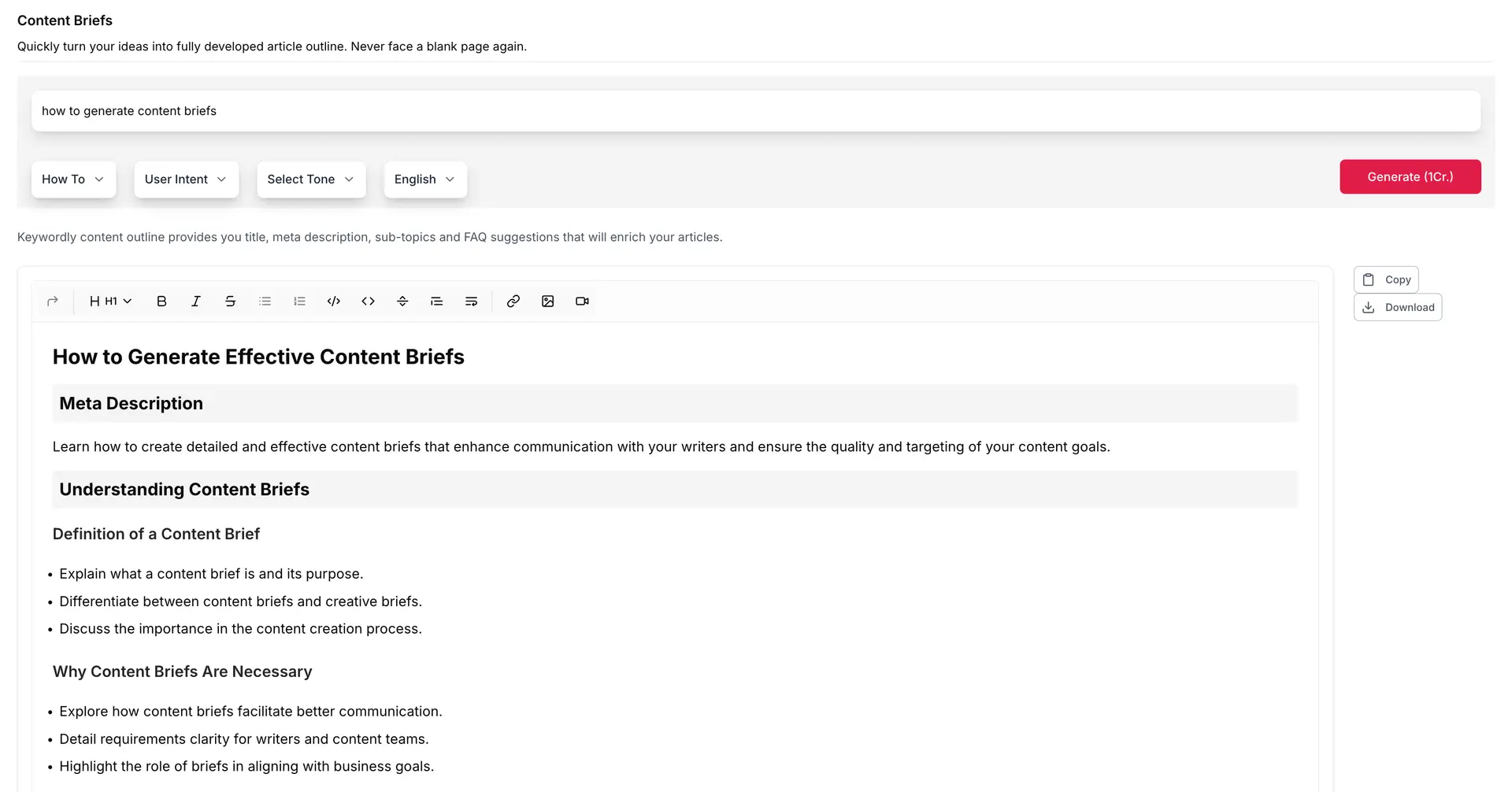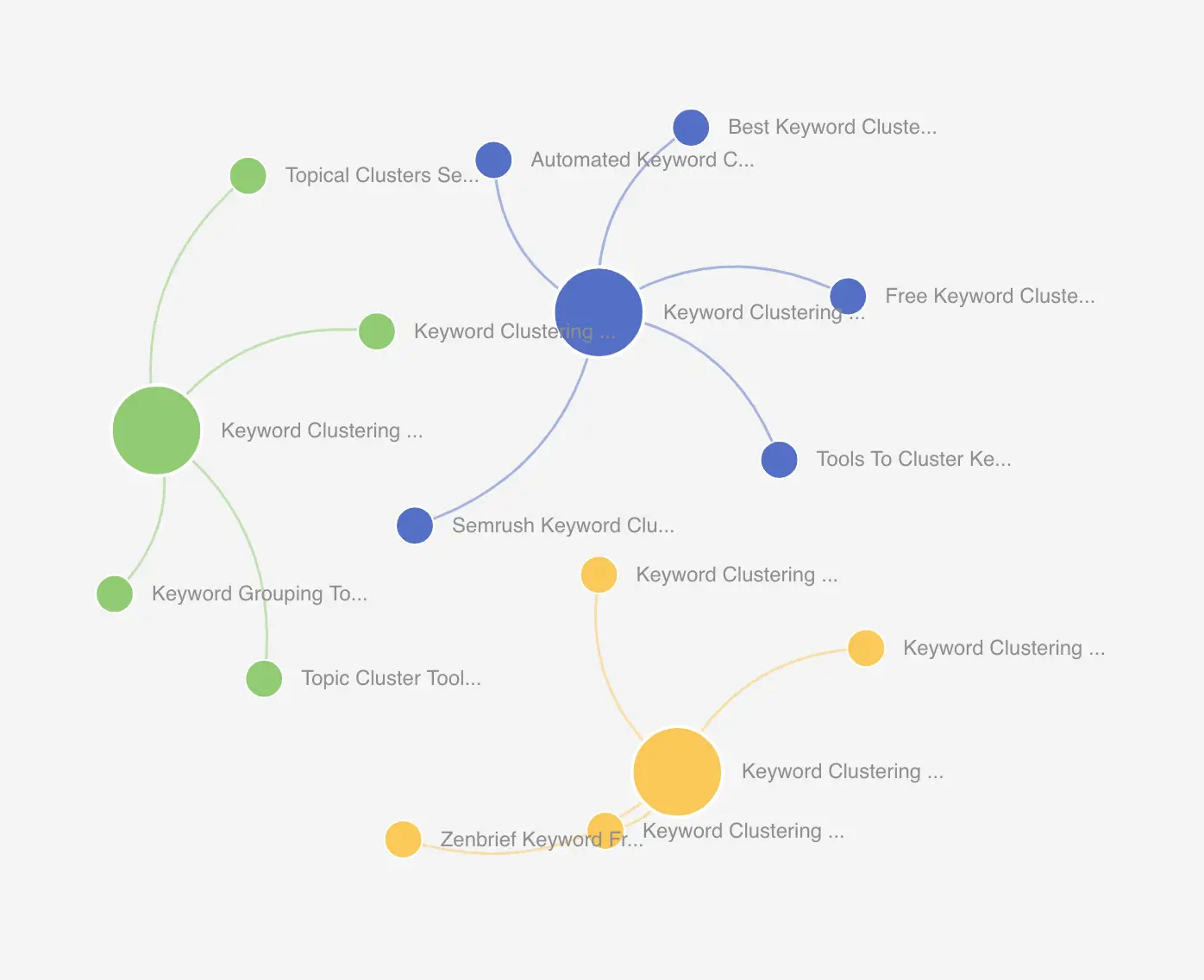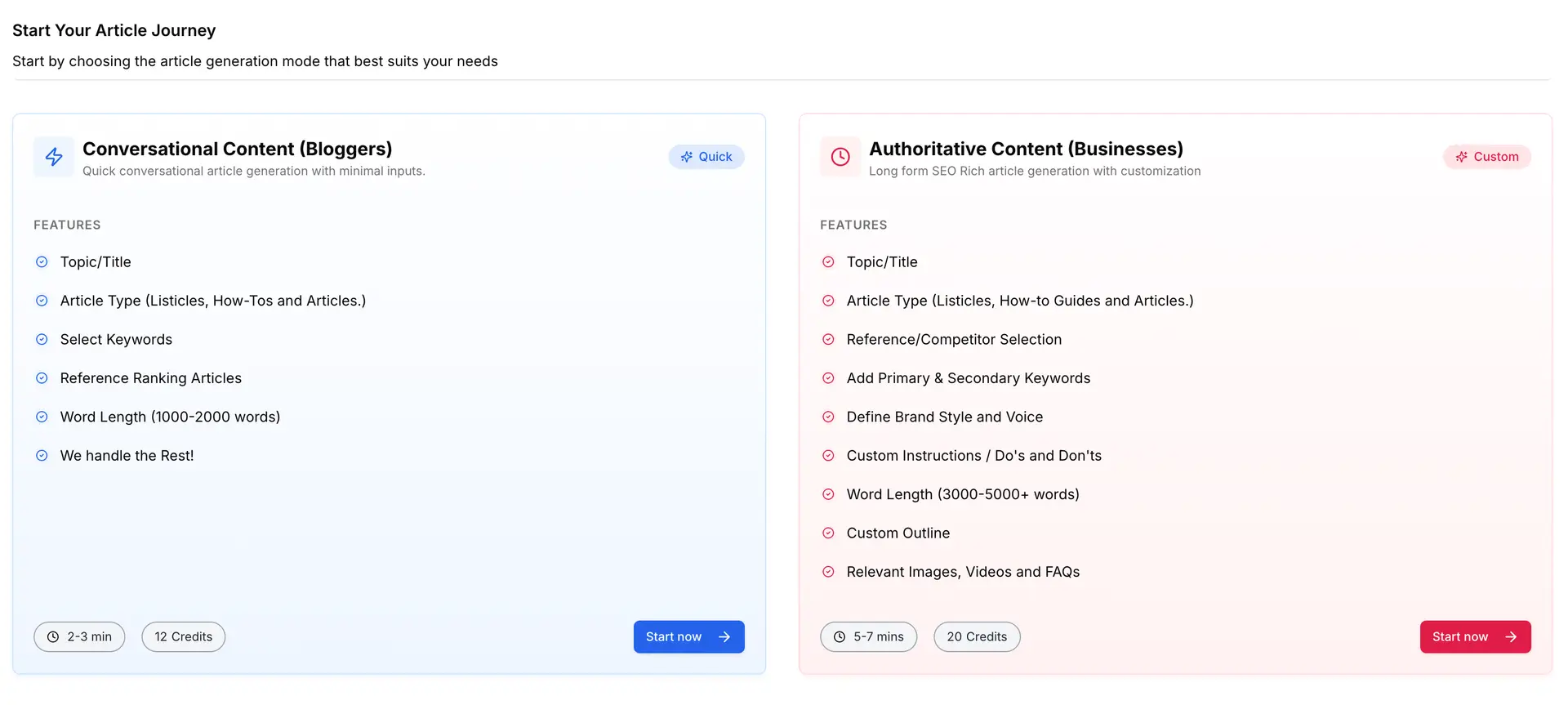Did you know that 70% of marketers say SEO is more effective than PPC at driving sales? Yet, many content briefs miss the mark, leaving writers and businesses frustrated by wasted effort and subpar rankings. If you’ve ever struggled to produce content that attracts organic traffic and meets brand goals, you’re not alone.
This expert guide reveals the step-by-step process for crafting powerful content briefs optimized for SEO success. You’ll learn how to research keywords, identify search intent, structure content, and ensure brand consistency—all powered by Keywordly’s integrated workflow. We’ll break down keyword discovery, clustering, intent analysis, and brief creation so you can start seeing measurable results. Expect practical tips you can implement in a couple of hours per brief, setting a strong foundation for lasting organic growth.
In the intricate dance of SEO, a meticulously crafted content brief is the choreographer that guides your steps towards ranking success, and Keywordly is the stage where your digital storytelling truly begins.
Understanding the Role of Content Briefs in an SEO Strategy
Content briefs have become indispensable for teams aiming to streamline SEO content creation and achieve better rankings. For brands like Keywordly, solid content briefs act as the blueprint that aligns SEO goals with business priorities and actionable content direction. Whether you’re working with an internal team or external writers, a well-structured content brief is key to translating high-level strategy into targeted, impactful content.
The Importance of Content Briefs for Effective Collaboration
Clear communication is vital when multiple stakeholders collaborate on SEO-driven content. Content briefs ensure everyone involved, from strategists to content creators, is on the same page regarding objectives, tone, and structure. With a concise brief, misunderstandings are minimized, deadlines are met, and quality is consistently maintained across diverse types of content.
How Content Briefs Bridge Strategy and Execution
A strong content brief connects the dots between keyword research, user intent, and content format. It serves as a roadmap that guides writers in creating content that reflects the brand’s SEO strategy while satisfying searcher needs. For instance, Keywordly’s integration of keyword clustering and intent analysis into briefs helps teams move seamlessly from research to content production, boosting both efficiency and rankings.
Key Elements That Make a Content Brief Valuable
To deliver value, a content brief should include essential elements such as primary and secondary keywords, target audience definition, preferred tone, structure guidelines, and content goals. Providing clarity on these factors helps minimize revisions, ensures accurate optimization, and improves content relevance. Anchoring briefs in up-to-date SEO data, some platforms like Keywordly automate this process, ensuring critical information is included from the outset.
Aligning Business Objectives with Content Creation
Every piece of content should contribute to core business goals—whether that’s increasing organic traffic, driving leads, or enhancing brand authority. Content briefs translate these broad objectives into actionable guidance for creators. By specifying the desired outcomes, target personas, and calls to action within briefs, brands ensure every article supports larger business achievements. As seen with digital agencies using Keywordly, precise briefs link KPIs with on-page actions for measurable impact.
Looking to generate content briefs that work? Try Keywordly

Let us look at the detailed steps you need to take to generate high quality content briefs.
1. Setting Clear Content Goals for Your Content Plan
[youtube=https://www.youtube.com/watch?v=25XzrenhasM]
Establishing solid content goals is essential for building an effective SEO strategy and ensuring that every piece of content serves a specific function.
By clarifying your objectives early, you create a focused roadmap that not only streamlines the content creation process but also aligns efforts across marketing, business, and SEO teams.
With platforms like Keywordly, teams gain the tools to systematize content planning, turning insights into measurable outcomes that drive organic traffic and boost brand visibility.
Defining the Purpose of Each Content Piece
Before beginning content production, it’s important to identify the purpose each piece serves—whether it’s to educate readers, generate leads, or build brand authority. For example, a B2B agency might develop in-depth guides to establish expertise, while an ecommerce brand targets transactional keywords to increase sales. Outlining these purposes within your content briefs ensures that each article or blog post stays focused, directly supporting overarching business and SEO objectives.
Aligning Briefs with Overall SEO and Business Strategy
Strategically crafted content briefs should map directly to your organization’s SEO and business goals. This means targeting keywords that matter, addressing user intent, and prioritizing topics that impact growth. With
Keywordly, you can align content briefs with strategic pillars such as authority-building, product awareness, or conversion optimization—helping teams prioritize the right topics and maintain consistency in message and value across different channels.
Identifying Target Metrics for Performance
Measure success by defining clear, actionable metrics for each content piece. Key performance indicators (KPIs) might include organic traffic, average time on page, conversions, or keyword rankings. For example, a SaaS business could track free trial sign-ups from educational blog content, while a media site follows engagement rates on news articles. These metrics create accountability and clarify expectations for all stakeholders involved.
Using Keywordly to Set Measurable Outcomes
Keywordly integrates keyword research and search intent analysis into the briefing process, enabling users to attach specific, measurable goals to each piece of content. For instance, using Keywordly, a content marketer can set goals for ranking on certain keywords, improving topical authority, and tracking organic growth by region or language.
Case studies show that organizations using Keywordly have accelerated their content’s impact by defining clear outcomes—such as increasing monthly organic sessions or achieving featured snippet placements for target queries.
2. Conducting Comprehensive Keyword Research

Effective keyword research is vital for achieving strong organic visibility. For content marketers and SEO professionals, choosing the right keywords sets the foundation for ranking well and attracting the target audience. Leveraging a powerful platform like Keywordly streamlines this process, integrating keyword selection, analysis, and alignment with your business goals.
Choosing the Right Keywords Using Keywordly’s Discovery Tools
Keyword selection starts with an understanding of your brand, target audience, and competition. Keywordly’s discovery tools provide actionable data by surfacing highly relevant search terms based on your focus topics. The platform’s automated suggestions help clarify which keywords are most likely to bring in valuable traffic. For example, an affiliate marketer using Keywordly for a fitness niche site can instantly find trending and high-conversion phrases without manual browsing through multiple tools.
Understanding Primary, Secondary, and Long-Tail Keywords
Keyword research is more effective when you distinguish between primary, secondary, and long-tail keywords. Primary keywords are your main focus—usually core products or services. Secondary keywords add context and support, while long-tail keywords are more specific and may capture lower-volume but highly targeted searches. For example, a digital marketer working with “SEO tools” (primary), could also target “best SEO workflow platforms” (secondary), and “how to create SEO content briefs with Keywordly” (long-tail).
Leveraging Keywordly for Keyword Research, Keyword Questions, and Organic Research
Keywordly offers a suite of research features that extend beyond basic keyword discovery. It enables question-based keyword exploration and organic ranking analysis to identify untapped opportunities.
By integrating these insights directly into your content briefs, you can ensure comprehensive topic coverage and answer real user queries. An agency optimizing for a SaaS client can quickly generate briefs addressing both high-value search terms and common customer questions using Keywordly’s workflow.
Mapping Keywords to Search Intent
Aligning keywords with search intent is essential for driving qualified traffic. Keywordly’s platform analyzes user intent—informational, navigational, commercial, or transactional—helping you select keywords that match the content’s purpose.
For instance, content marketers can use intent signals to decide whether to focus on how-to guides, reviews, or product pages, increasing the likelihood of meeting user needs and boosting engagement.
Evaluating Keyword Competitiveness for Your Niche
Understanding the competition around each keyword is crucial for planning realistic strategies. Keywordly’s competitive analysis tools assess search volume, keyword difficulty, and the strength of top-ranking domains so you can target phrases within reach.
For example, a small business owner might avoid high-competition keywords and instead focus on niche opportunities identified through Keywordly’s suggestions, leading to faster ranking improvements and higher ROI.
3. Analyzing Search Intent to Inform Content Direction
[youtube=https://www.youtube.com/watch?v=Q8rN3JKqUc8]
Understanding why users perform certain searches is a foundational part of successful SEO content. By pinpointing the true motivations behind keywords, content creators can craft material that directly addresses user needs, increases engagement, and improves ranking potential.
Keywordly integrates search intent insights directly into the content brief process, creating a workflow that bridges data with strategy.
Types of Search Intent and Their Impact on Briefs
Before mapping out content topics, it’s important to categorize search intent. Generally, intent can be informational (seeking knowledge), navigational (seeking a website), transactional (looking to make a purchase), or commercial investigation (comparing solutions).
Recognizing the type influences not only what is written, but also which calls-to-action (CTAs) are most effective, the tone to use, and whether to focus on educating, guiding, or selling. For example, a brief for an informational query should prioritize clarity and depth, while transactional intent requires actionable, persuasive language and conversion optimization.
Tools and Techniques to Analyze Searcher Intent
Multiple tools can be leveraged to decode searcher intent. Reviewing keyword modifiers (such as “how to” or “buy”) and analyzing top-ranking pages for those keywords uncovers user motivations.
Tools like Keywordly streamline this process by clustering keywords and labeling intent automatically. Comparing Google Search features like featured snippets, image packs, or shopping results can give further hints. Manual SERP analysis also remains a valuable cross-check to validate tool-generated insights.

Integrating Intent into Topic Selection
After intent is defined, the next step is weaving it into topic ideation. Each topic should map directly to a clear intent type, ensuring content fulfills users’ immediate needs and ranking chances are maximized. Start by grouping keywords by intent, brainstorm topics around user questions or problems, and then outline content angles and recommended formats (such as how-tos or product reviews). This ensures briefs are aligned with user expectations at every stage.
Leveraging Keywordly for Automated Intent Insights
Keywordly’s platform expedites intent analysis by automatically labeling keyword clusters by intent, saving hours of manual research. For example, a client in the fitness industry used Keywordly to discover that a large portion of their traffic came from informational searches about workout routines rather than transactional queries.
By recalibrating their briefs toward in-depth guides, they experienced a 30% uplift in organic traffic within six months. Businesses can similarly harness Keywordly’s full-stack workflow for efficient, intent-led content strategies.
https://cognitiveseo.com/blog/22986/search-intent/
5. Defining Target Audience and User Personas

Establishing your target audience and developing detailed user personas are crucial for creating impactful content that resonates with your desired readers. With Keywordly’s SEO workflow platform, businesses can strategically approach audience analysis for content marketers, SEO professionals, business owners, digital marketers, and affiliate marketers. By tailoring your content briefs based on accurate audience insights, you not only enhance engagement but also align your messaging with search intent and brand goals in the US market.
Outlining Your Audience Demographic and Psychographic Data
Demographics and psychographics together paint a comprehensive picture of who your audience is and what motivates them. Demographic data involves basic characteristics like age, gender, location (with a US focus), income, and occupation, while psychographic information explores interests, values, and buying behavior. Collecting this data helps Keywordly users craft content briefs that directly address real users’ motivations and challenges, ultimately driving organic traffic and improving rankings.
- Use Google Analytics and social media insights to map audience age groups, locations, and professional backgrounds.
- Survey your US-based customers about their goals, pain points, and content preferences for deeper psychographic understanding.
Creating Actionable User Personas for Writers
User personas are fictional representations of your ideal readers, defined by their attributes, needs, and search intent. When Keywordly users provide persona details—such as the savvy business owner looking to scale their organic reach—they give writers clear guidance for content tone and structure. Detailing personas also ensures SEO content briefs reflect specific goals for each audience segment, increasing the likelihood of engagement and conversions.
- Develop 2-3 personas representing typical content marketers, digital marketers, and affiliate marketers in the US.
- Share these personas with writers to personalize content outlines, guiding them on writing style and depth.
Customizing Messaging for Specific Segments
Precision in messaging amplifies relevance for each segment you target. With Keywordly’s data-driven briefs, brands can adapt messaging to address unique challenges, vocabulary, and intent of US-based professionals. This method not only promotes clarity but also increases conversion potential, as customers receive answers tailored to their sector—whether affiliate marketing or SEO implementation.
- Group users by role—such as SEO professionals or business owners—and adjust messaging in your briefs to meet their information needs.
- For example, offer case studies that show how businesses in the US improved organic traffic using Keywordly’s integrated SEO workflow.
Adapting Language and Tone for a US-Based Audience
Writing for a US audience requires awareness of language nuances, tone, and cultural context. Keywordly makes it straightforward for writers to embrace American English, employ an informative yet conversational style, and avoid jargon that may alienate readers. With this approach, content remains accessible and engaging, thereby strengthening brand presence in the competitive US market.
- Edit briefs to include industry terms familiar to American professionals and avoid region-specific language that could confuse users.
- Reference relatable US case studies—such as a content marketer boosting search rankings using precise keyword clustering—to enhance user trust and content relatability.
6. Outlining Structure and Content Requirements
[youtube=https://www.youtube.com/watch?v=_s2h7X-c2jE]
Well-structured content is the foundation of effective SEO and user engagement. For platforms like Keywordly, creating detailed outlines ensures writers produce consistent, high-quality articles optimized for both search engines and readers. Outlining helps target search intent, organize relevant information, and align with business goals. Below are the essential steps to define and enhance your content structure and requirements.
Defining Ideal Word Count and Article Format
Start by determining the optimal word count based on target keywords, content type, and competitive analysis. Typically, longer articles (1,500–2,500 words) outperform shorter ones in organic search, but precise length should reflect topic complexity and audience expectations. Choosing the right format—such as guides, how-tos, or listicles—aligns content with user intent and improves readability, a core benefit offered by integrated platforms like Keywordly.
Creating Detailed Content Outlines with H2s and H3s
Break down the article into H2 and H3 headings to map out the logical flow of information. Outlines provide clarity for writers by making sure all relevant subtopics, supporting details, and keyword opportunities are covered. This structured approach, supported by Keywordly’s content brief generation, ensures consistency across multiple writers and speeds up the editorial process.
Specifying Must-Have Sections, CTAs, and Internal Links
Identify mandatory sections such as introductions, conclusions, FAQs, or expert tips that are vital for thorough coverage and engagement. Incorporate clear calls to action—like newsletter signups or demo requests—to drive conversions. Including recommended internal links to related articles or product pages not only bolsters SEO but enhances user navigation, which Keywordly automates through its workflow.
Incorporating Visual and Data Requirements for Clarity
Detail the types and placements of visuals such as images, charts, or infographics needed to clarify complex topics and break up text. Outline specific data points, case studies, or real-world examples to substantiate claims and add credibility. For instance, referencing Keywordly’s success in streamlining SEO workflow or sharing client results enhances trust and helps readers connect theory to practice.
https://www.lib.jjay.cuny.edu/content/how-write-outline
7. Integrating SEO Best Practices into Briefs

Building effective content briefs is central to optimizing written content for organic traffic and visibility. At Keywordly, integrating SEO best practices is a cornerstone of our workflow, ensuring that every brief provides actionable, research-backed directives for writers.
By coupling core SEO strategies with content planning, marketers can consistently achieve higher rankings and a greater impact in the search results.
On-Page SEO Elements: Title Tags, Meta Descriptions, Headers
On-page SEO elements offer a foundational layer for improving a page’s relevance and discoverability. Title tags should be concise, include the target keyword, and engage users with a clear benefit. Meta descriptions should quickly summarize the content and entice clicks, while headers (H1, H2, H3) are used to structure content, making it accessible for both readers and search engines.
For instance, a business in the travel niche saw a 30% increase in organic clicks after rewriting titles and headers to better reflect search intent and relevant keywords—an approach facilitated by the Keywordly platform.
Internal and External Linking Strategies
Effective briefs guide content creators on inserting appropriate internal and external links. Internal links distribute authority throughout a site, help users discover related information, and signal content hierarchy to search engines. External links to reputable sources enhance credibility and context for your audience.
A SaaS company using Keywordly found their average session duration improved by 22% after refining their internal linking strategy within briefs, making content more interconnected and retaining user interest.
Guidelines for Keyword Placement and Density
Proper keyword usage is essential for signaling topic relevance without over-optimization. Content briefs should specify primary and secondary keywords, recommended placements (e.g., introduction, headers, conclusion), and a balanced keyword density (typically 1-2%). Avoid keyword stuffing, as it harms readability and rankings.
Keywordly’s data-driven briefs leverage search intent analysis to recommend strategic keyword placement, helping writers maintain a natural flow while meeting SEO objectives.
Leveraging Schema, FAQs, and Featured Snippets
Including schema markup, FAQ sections, and content targeting featured snippets can dramatically improve a page’s visibility. Schema markup enables enhanced listings that stand out in the SERPs, while well-structured FAQ sections help target long-tail keywords and voice search queries.
A financial blog integrated schema and FAQ recommendations via Keywordly, resulting in two of their articles being chosen for Google featured snippets, increasing organic traffic by 18% within a month.
8. Customizing Briefs for Brand Consistency and Voice
For businesses using Keywordly, maintaining a distinct and unified brand voice across all content is essential to build trust, improve recognition, and enhance SEO performance. Content briefs become the blueprint for writers and marketers to ensure every article, blog, or landing page accurately reflects the company’s identity and values. Here is how you can customize briefs to ensure brand consistency and adaptability—especially in the US digital market.
Outlining the Brand’s Tone, Language, and Style
Before delegating content creation, define the tone, language, and stylistic preferences that embody your brand. Whether you want a formal, informative voice or a conversational and approachable style, explain these expectations within your briefs. For example, a data-driven SaaS like Keywordly might favor clear, authoritative language with industry terminology for professional audiences while avoiding jargon when simplicity is required for wider reach.
Providing Writing Do’s and Don’ts for Keywordly Content
Consistently high-quality content stems from clear guidance on what works for your brand—and which approaches could dilute its message. Specify actionable do’s, like referencing keyword data or prioritizing clarity, and don’ts, such as avoiding sensationalism or informal greetings. These lists help writers understand boundaries, creating content that resonates with Keywordly’s audience of marketers and business professionals.
Setting Standards for Quality and Originality
Establish explicit benchmarks for thorough research, accuracy, and uniqueness. Include instructions on organic keyword integration, plagiarism checks, and citation practices. This level of detail reinforces Keywordly’s reputation for reliable information and supports higher search visibility by preventing duplicate or thin content. Brands like Moz or HubSpot frequently use tailored briefs to uphold this quality standard.
Ensuring Compliance with US Market Nuances
If targeting the American audience, adjust briefs to include local idioms, spelling, and cultural references. Highlight compliance requirements relevant to US readers, such as FTC guidelines for sponsored content or accessibility standards. Taking these steps protects your brand from miscommunication while optimizing engagement and conversion—Cornerstone brands often reference US-specific events or statistics to connect authentically with their local audience.
9. Writing Articles Based on the Content Briefs
Creating high-impact articles from content briefs is essential for maintaining consistent brand messaging and ranking well in search engines. Keywordly supports writers at every stage, ensuring article creation aligns with SEO strategies and directly addresses audience intent. Leveraging a well-structured content brief enables teams to produce targeted content that resonates with readers and drives measurable results.
Using Keywordly’s Conversational and Long-form Article Generation
Keywordly’s content generation tools empower users to produce articles in a conversational tone, suitable for diverse audiences while meeting SEO requirements. Whether you need quick responses for FAQs or comprehensive guides, Keywordly adapts to your content needs, optimizing for both reader engagement and search visibility. This versatility allows marketers and writers to choose the right approach for each topic, ensuring alignment with campaign goals and search behaviors.

- With conversational article generation, you can efficiently create How-To guides and knowledge resources that speak directly to your audience, increasing on-page retention and user satisfaction.
- The long-form content option is designed for in-depth explorations of subjects, drawing from extensive keyword and topic data drawn from the content brief to provide thorough, authoritative coverage.
Generate Quality How-Tos, Product Listics & Articles Based on Your Content Brief
Utilizing a structured content brief, writers can effortlessly craft high-quality How-To guides, product listicles, and in-depth articles tailored to target keywords and search intent. Keywordly’s automated workflow guides content creators through every step, from outlining essential points to ensuring SEO best practices are observed throughout the piece. This helps streamline editorial planning and significantly reduces content development time.
- How-To guides generated from Keywordly’s briefs address specific problems your audience faces, providing actionable solutions that improve engagement and support conversion goals.
- Product listicles, backed by structured keyword data and market research, help users easily compare options and make informed purchasing decisions, benefiting affiliate marketers and e-commerce brands.
Analyzing What Works Through Keywordly’s Ranked Keywords
Evaluating the performance of your written articles is integral to refining and scaling your SEO strategy. Keywordly enables you to monitor which keywords from your brief are achieving top search engine rankings, giving you actionable insights into what content resonates best with your audience. This ongoing analysis helps inform future content production and adjustment of strategies for maximum impact.
- By reviewing ranked keywords, businesses gain a clearer picture of topics and formats that generate organic traffic, guiding editorial calendars and resource allocation for better ROI.
- Case studies show that continuous optimization based on keyword rankings has led to increased brand visibility and traffic for a variety of industries utilizing the Keywordly platform.
https://wordable.io/content-brief/
Conclusion
Summarizing the Step-by-Step Approach to Crafting SEO-Optimized Content Briefs
To successfully craft SEO-optimized content briefs, it’s necessary to follow a systematic, actionable process. Start by clarifying the goal and target audience, then move into meticulous keyword research and mapping. From structuring the outline to aligning tone and user intent, each step builds a foundation for search visibility and content performance. For instance, brands leveraging Keywordly integrate these steps to produce briefs that consistently enhance organic rankings, resulting in sustained traffic growth and higher content ROI.
Importance of Purpose-Driven Planning, Keyword Research, and Alignment with Business and Audience Needs
Purpose-driven planning ensures every brief addresses both business goals and the genuine needs of the audience. Effective keyword research uncovers high-potential topics while aligning messaging with what searchers seek. Case studies show that companies tailoring briefs to both brand objectives and user queries see improved engagement and lower bounce rates. Ultimately, this alignment builds brand authority and fosters deeper customer trust.
Leveraging Tools like Keywordly for Consistent, Measurable, and Scalable Results
Adopting workflow platforms such as Keywordly enables teams to standardize and streamline brief creation at scale. By automatically integrating keyword clustering, intent analysis, and SEO best practices, Keywordly removes guesswork from the content planning process.
Businesses have reported faster turnaround times, improved SERP rankings, and measurable content outcomes with the platform’s data-driven approach. This level of consistency empowers teams to ramp up volume without sacrificing quality or strategy.
Mastering These Steps Positions Your Content Strategy for Sustained SEO Success and Brand Visibility
Refining each step of the SEO content brief process ensures continuous improvement and long-term results. By consistently applying these techniques, brands enhance their visibility, outperform competitors, and meet evolving search engine standards.
With platforms like Keywordly, marketers can anticipate trends, fill content gaps, and reinforce their brand’s digital presence. Staying committed to this structured approach is key to achieving ongoing SEO and business growth.
https://www.merriam-webster.com/dictionary/conclusion
FAQs
Understanding Content Briefs in SEO
Content briefs form the foundation of a strong SEO-driven content strategy. They outline specifics for writers, aligning deliverables with search intent, keyword targets, and brand voice. Without them, teams risk producing content that misses the mark in both engagement and rankings.
What is the main purpose of a content brief in SEO content creation?
- The core purpose of a content brief is to ensure every piece of content meets SEO goals and resonates with the audience. A well-structured brief directs content creators by providing details such as primary and secondary keywords, topics to cover, structure, user intent, and tone. This ensures content is consistently optimized and targeted for search engines and readers alike, increasing the chances for higher rankings and engagement.
Leveraging Automation with Keywordly
With platforms like Keywordly, content teams can automate the often-complex process of brief creation. This improves efficiency while ensuring briefs remain data-driven and up to date.
How does Keywordly help automate content brief creation?
- Keywordly streamlines the content brief creation process by automatically integrating keyword data, search intent analysis, language, and regional considerations into one comprehensive outline. By consolidating these elements, Keywordly enables marketers and writers to begin content creation with actionable, SEO-optimized directions in minutes, reducing manual research and improving workflow consistency across an organization.
Key Elements for Effective Content Briefs
For the most impactful results, a content brief must go beyond just a list of keywords. It should serve as a roadmap encouraging consistent quality and alignment across diverse content assets.
What should be included in a content brief for maximum effectiveness?
- Effective content briefs cover keyword targets, user intent, target audience, structure (headlines and subheadings), internal/external link guidance, and on-page elements like meta descriptions. Real-world examples include agency workflows where specific competitor references and SERP feature opportunities are explicitly mapped inside briefs, boosting content’s competitive edge.
Maintenance and Customization of Briefs
SEO trends and business objectives evolve, necessitating ongoing review and adaptation of briefs, especially when leveraging platforms like Keywordly for varying content types.
How often should content briefs be updated or reviewed?
- Content briefs should be reviewed before each significant content update or at least quarterly to ensure alignment with changes in keyword trends, user intent, or brand strategy. For example, a digital marketing agency might revisit briefs monthly to adapt to competitors’ moves or algorithm updates.
Can content briefs be customized for different types of content (e.g., blog posts, landing pages)?
- Absolutely, content briefs can and should be tailored to specific formats like blog posts, service pages, or product listings. Customization allows brands to focus efforts effectively; for instance, briefs for landing pages prioritize conversion elements, while blog post briefs may emphasize depth and informational value.
Common Mistakes to Avoid
Even experienced teams make missteps during the content briefing process that can affect output quality and ROI.
What are common mistakes to avoid when creating SEO content briefs?
- Key pitfalls include neglecting search intent, failing to update keyword strategies, providing vague instructions, or omitting competitor context. Avoiding these errors—like ensuring clear keyword rationale and using Keywordly’s structured workflow—helps teams produce high-quality, ranking content consistently.
